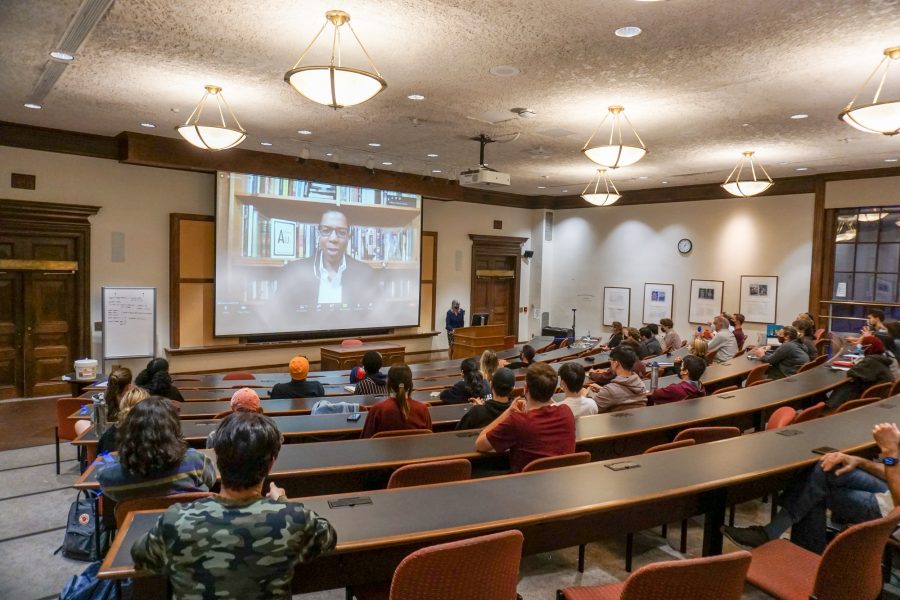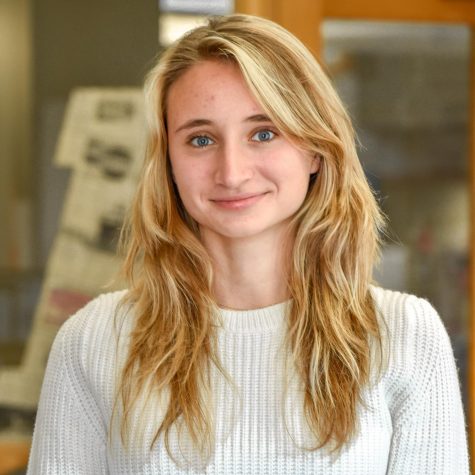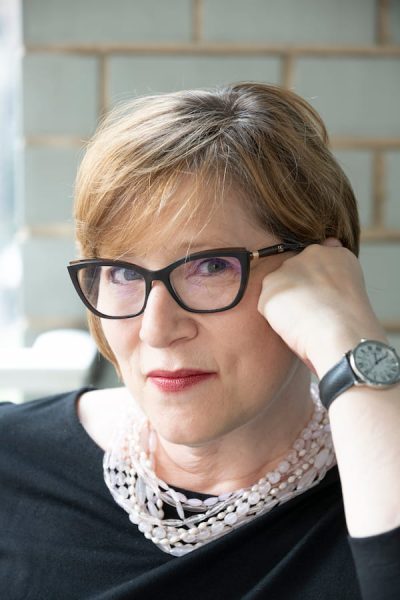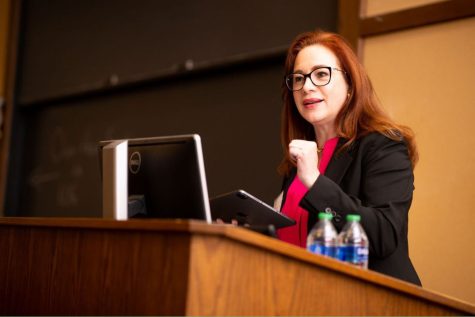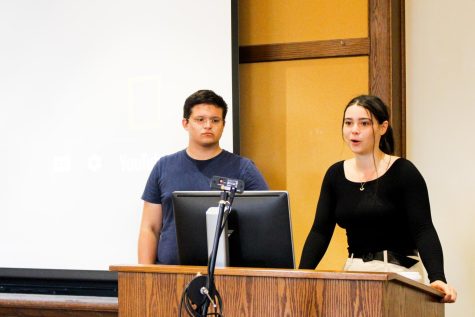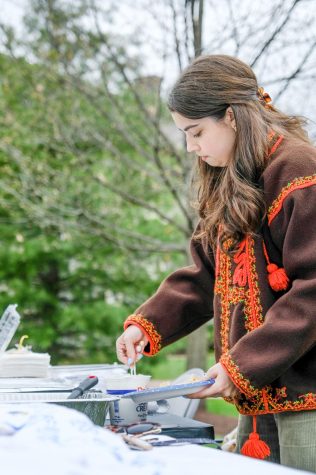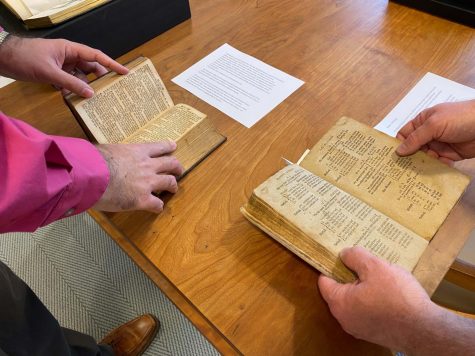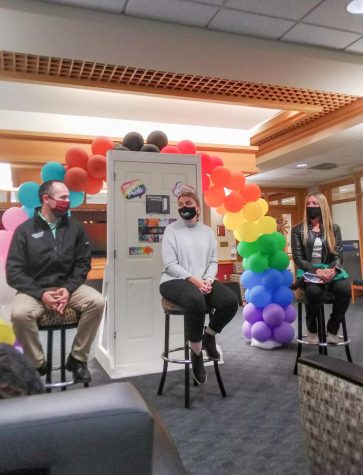How humans and materials shaped each other: Ainissa Ramirez speaks to the influence of technology on society
While sharing her love for the topic with Lafayette students, Ainissa Ramirez emphasized the importance that everyone have a seat at the table in conversations about science. (Photo by Pierson White ’24)
October 1, 2021
From the mass production of lightbulbs to the invention of the GPS, countless little-known Black inventors have contributed to the technologically advanced world we have today.
“These are things that I had no idea of growing up and only learned recently and as an adult,” Ainissa Ramirez, an award-winning material scientist and science communicator, said. “I am busily trying to uncover those things, and that’s my more recent work. But what primed all this activity was my love for science and my desire to provide more reflections for people to see themselves in the sciences. That is the book, [‘The Alchemy of Us: How Humans and Matter Transformed One Another’].”
Last Tuesday, Ramirez spoke to the Lafayette community on Zoom about her book and her experience as an African American woman in STEM. Ramirez earned her doctorate at Stanford and went on to work as a researcher at Bell Labs and as a mechanical engineering professor at Yale University. She has won awards from the Massachusetts Institute of Technology, the National Science Foundation, the Alfred P. Sloan Foundation and the American Institute of Physics.
Ramirez has known she wanted to become a scientist ever since she was young. Science was always her favorite topic; she spent her free time taking things apart but not always putting them back together. She was constantly curious about how things worked.
She shared with the audience that despite her inquisitiveness for the world around her, what convinced her to become a scientist was one of the many shows she grew up watching on television with her younger brothers.
“It was called 3-2-1 Contact. It had a repeating segment of kids solving problems, kids were a little older than I, but one of those kids was an African American girl. And when I saw her, I saw my reflection,” Ramirez said. “When I found out what she was doing was using her brain and asking questions and being curious like me and what she was doing with science, I said ‘I want to do science.’”
With this love for science instilled within her to this day, Ramirez described her newest book as a material science book in disguise.
“It comes from a desire to share science with everyone because I think everyone should have a place at the table with science. Not everybody needs to become a scientist, we don’t need that. But we need everyone to be part of the conversation because there’s so many things around us that have some kind of science leaning towards them,” Ramirez said. “When we talk about climate change or when we talk about our health, we need people to feel comfortable with science. And so that was the reason why I feel so compelled to make science understandable.”
Rather than teach others with scientific jargon, Ramirez spoke on the importance of using stories to share information, a different approach to communicating science than what is used by many of her colleagues.
Ramirez went on to share a story of a glassblowing class she took, and the importance that one day had in shaping her book.
While she was distracted after a tough day, she was working with the glass and was too confident and cavalier. As a result, a huge piece of glass fell to the floor. After the dangerous situation was resolved, she realized that she felt better than she did before she made the mistake.
“This made me think, I wonder how materials and humans have been shaping each other over the last few centuries. That was the birth book. Now I had my theme. I had my desire to bring science to people because I wanted them to see their reflections,” Ramirez explained. “I wanted to show the beauty of material science, and I wanted them to see this theme of how these materials that we don’t even think about, how they have changed us radically.”
Throughout the night, Ramirez told stories that highlighted what makes her passionate about material science and what is in her book.
Ramirez shared a story about William Wallace’s contribution to the electric lightbulb and the unintentional health consequences of being exposed to the blue light that lightbulbs emit long after the sun has set. These include a higher risk for certain ailments, such as cardiovascular disease, obesity and some forms of cancer.
“We’ve seen that technology can give rise to surprises. We’ve seen how technology can give rise to unintended consequences. Let’s look now, and explore how sometimes technology can go awry, and a great case study to that is actually photography,” Ramirez said.
The next story Ramirez told was about Polaroid’s involvement in the Apartheid. In South Africa during this time, every Black citizen had to carry a passbook with them that stated where they lived and where they were allowed to travel. Anyone who did not have their passbook would be fined or forced to do a month of hard labor. At the heart of this passbook was a picture of the individual, and this picture was made by Polaroid.
“Here’s where technology go can go awry, but it’s up to us to make sure that it’s pulled back so that it serves humanity. If you read books about Polaroid, you don’t hear about the story because those authors don’t want to tell this whole science story. But it’s important because it’s a parable so we can figure out how we can live well today,” Ramirez said.
Ramirez ended her talk by sharing that she hopes that the audience takes a new approach to technology, and rather than just embrace it, “to examine it, to ask it questions.”
“It’s important to ask questions,” Ramirez said. “Such a thoughtful analysis of the impact of inventions benefits society. Not just because it’s an entertaining cerebral exercise, but because when coupled with action and social change, it has the potential to help society transcend its condition and favorably further this alchemy of us.”



































































































